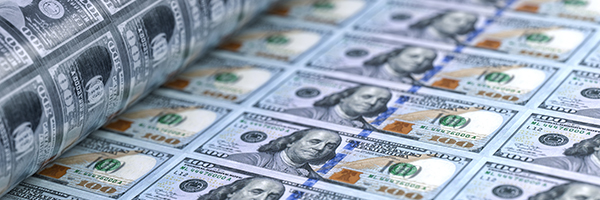Mid Term

October 4, 2023 | Daily JAM, Mid Term |
Yesterday, October 3, the yield on the 30-year U.S. Treasury hit 5% for the first time since 2007. The yield on the German 10-year bond hit 3% for the first time since 2011. In one financial market after another higher U.S. yields are driving global bond prices lower and bond yields higher.

October 3, 2023 | Daily JAM, Mid Term, Morning Briefing |
Where did the slow-moving, deep and placid Treasury market go? The yield on the 10-year benchmark Treasury–you know the one used to set the interest rate on things like mortgages–moved up another 13 basis points today, October 3, to 4.80%. That’s a jump to 24 basis points in just two days. The Treasury market just doesn’t move like this. The yield on the 10-year Treasury is now up 63 basis points in the last month.

October 2, 2023 | Daily JAM, Mid Term, Morning Briefing |
Despite the Wall Street consensus that there won’t be an interest rate increase at the Federal Reserve’s November 1 meeting, Treasury yields keep climbing. The yield on the 10-year Treasury closed at 4.68% today, October 2.
September 28, 2023 | Daily JAM, Mid Term |
Consumer spending, which accounts for about 70% of U.S. economic activity, rose an annualized 0.8% in the April-to-June quarter, according to the third estimate of gross domestic product from the Bureau of Economic Analysis. The last estimate put the annualized growth rate at 1.7%.

September 28, 2023 | Daily JAM, Mid Term, Morning Briefing |
Mortgage rates surged to a 23-year high this week. The rate on the average 30-year fixed mortgage increased to 7.31% from 7.19% the week prior, according to Freddie Mac. That’s the highest rate since mid-December 2000, when it averaged 7.42%.

September 24, 2023 | Daily JAM, Mid Term |
The Standard & Poor’s 500 index (closing price) peaked on July 31 at 4588.96. The index is down 5.9% since then (as of the September 22 close.) That’s not correction territory (a drop of 10% ore more) but I’d say stocks can feel the hot breath of a correction on the back of their necks, The small-cap Russell 2000 Index has lost more than 11% from its July 31 closing high, roughly twice the decline in the S&P 500 Index over the same time. There are other signs of trouble in the stock market.

September 22, 2023 | Daily JAM, Mid Term, Morning Briefing |
Yeah, you’ve read all the stories about who will get hurt by a government shutdown–folks who need passports, communities in need of disaster aid, childcare centers, air travelers–and I’m sure your full up to your eyeballs with stories about how the Republican majority in in House is so dysfunctional that Speaker Kevin McCarthy couldn’t win a vote to declare water wet. But I’ve got some really good news: because the statisticians who compile the data on GDP, employment trends, producer and consumer prices, and other indicators that track the economy will be furloughed if the government shuts down, we’re not likely to know the full extent of the damage until we’re well into what could be a prolonged shutdown. Of course, it’s not clear that not knowing will be appreciated by financial markets that are already looking a bit anxious.

September 19, 2023 | Daily JAM, Mid Term, Special Reports |
In this Special Report I’m going to start by sorting out the data that the market’s moves will likely depend on for the rest of 2023. That’s today’s post, Part 1 of this Special Report. Then I’ll try to handicap the likelihood that the data will zig or zag. And give you a sense of how far away from the current consensus the actual result might fall. And then finally, I’ll give you 10 moves for the rest of 2023 that are the most likely, in my opinion, to result in profits and that won’t wind up costing you big if the data winds up throwing investors a curve.

September 15, 2023 | Daily JAM, Mid Term, Morning Briefing |
Taiwan Semiconductor Manufacturing (TSM), the company that makes the chips for everyone from Apple to Nvidia, has told suppliers to delay some deliveries amid concerns about slowing chip demand, according to a new report Friday from Reuters. The company has told large chip-equipment suppliers to delay some deliveries, Reuters reported. The company is “increasingly nervous” about demand from its customers, the report said.Last week, the company said its August revenue fell 13.5% from last year but rose 6.2% from the prior month. As you might imagine, the news wasn’t greeted with cheers by investors in technology stocks.

September 14, 2023 | Daily JAM, Dividend Income, Jubak Picks, Mid Term, SCCO, Top 50 Stocks |
The People’s Bank of China cut the amount of cash banks must hold in reserve for the second time this year. The move is an effort to boost flagging economic growth in China. The bank could have cut its benchmark interest rate in pursuit of the same goal. But that would have led to more selling against the yuan and the People’s Bank has been busy in the trenches in recent weeks trying to prop up the yuan agains the dollar. The question, of course, is whether the cut in reserve requirements will be enough, without a reduction in interest rates, to revive growth in China’s economy.

September 13, 2023 | Daily JAM, Mid Term, Morning Briefing |
The theory, for today at least, is that the uptick in CPI inflation for August doesn’t change the basis calculus at the Federal Reserve.

September 1, 2023 | Daily JAM, Mid Term |
More American consumers fell behind on their car loan and credit card payments in the last quarter than at any time in more than a decade. The problem is most acute for lower-income consumers who have exhausted the money from government stimulus checks during the Pandemic and who are seeing breaks on rent and student debt expire. Higher interest rates from the Federal Reserve aren’t helping any. The average credit card interest rate is already at a record high 20.6%, according to Bankrate.com, and could well continue climbing if the Fed tightens further in its fight against inflation. Student loan payments that were paused for more than three years are poised to resume in October. And banks and other lenders have been clamping down on credit lines for months after the spring banking turmoil. There is, of course, the question of whether the Fed is “happy” with this trend.













